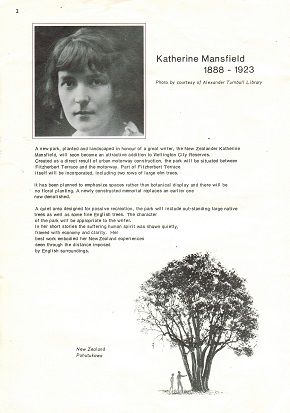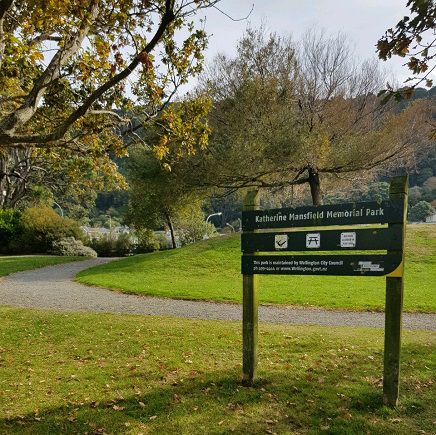IMMEMORIAL: THE STORY OF THE KATHERINE MANSFIELD MEMORIAL
- 18 May 2020
- Cherie Jacobson
1965. New Zealand literary luminaries Dame Ngaio Marsh and Frank Sargeson pose for a photograph, walking beneath the Katherine Mansfield Memorial at the south end of Fitzherbert Terrace in Thorndon. A long path, bordered on each side by established trees, stretches out behind them. Sargeson has recently won the Bank of New Zealand Katherine Mansfield Memorial Award for his short story ‘Just trespassing, thanks.’
.jpg?202005180631)
Image: Dame Ngaio Marsh and Frank Sargeson emerge from the Katherine Mansfield Memorial, 1965. Courtesy of the Alexander Turnbull Library, 1/2-038572-F.
More than 30 year earlier, in December 1932, the Evening Post reported that Mansfield’s father, Sir Harold Beauchamp, “desired to erect a memorial to his daughter, the late Katherine Mansfield, and suggested that the memorial should take the form of a small building, suitable for use as a tramway shelter, at the Molesworth street end of Fitzherbert terrace, at a cost of £500.”[1]
The location was significant, being only metres away from 47 Fitzherbert Terrace, where Mansfield lived with her family during her last 15 months in New Zealand. It was also close to the site of one of her former schools, Miss Swainson’s, further north on the same street.
.jpg?202005180632)
Image: A plan illustrating the layout of the Katherine Mansfield Memorial, 1933. Courtesy of the Wellington City Archives Online, 4484.
Architect William Gray Young, fresh from designing the not-yet-completed Wellington Railway Station, drew up a “rest-house in keeping with the surroundings, there being two "houses" of red brick with shingled roofs...connected by a trellised pergola, and plenty of seats facing several directions.”[2] The tender of H. G. Field & Co. was accepted by Sir Harold in February 1933 and construction began soon after.[3]
The form of the Memorial was apparently suggested to Sir Harold by Isao Hashimoto, a Japanese merchant who visited New Zealand in February 1932.[4] The primary purpose of Hashimoto’s trip was trade-related, however, he also had ambitions to write about Mansfield’s life and translate her stories into Japanese, so had met with Sir Harold as part of his research.[5]
A tramway shelter might initially seem like a strange choice as a memorial for a writer. However, it could be considered quite apt, given the transient nature of Mansfield’s adult life and the frequency with which trains, boats and liminal spaces (such as train stations, stairs and windows) feature in her writing.
Before it was even completed the Memorial attracted criticism, namely from the Wellington Automobile Club who complained that its location and size were a danger to motorists.[6] The Chairman of the Club stated, “It was stupidity to put the memorial in the middle of an intersection like that."[7] There may have been others who had reservations of a different nature. During a speech to the Writers’ and Artists’ Society, Australian journalist and poet Will Lawson observed that “The Katherine Mansfield memorial had aroused a great deal of discussion...but...the erection of the memorial was a wonderful thing for New Zealand. It showed that literature was becoming an important item.”[8]

Image: The completed Katherine Mansfield Memorial at the south end of Fitzherbert Terrace, c.1930s. On the right, a car is parked in front of the Beauchamps' former Fitzherbert Terrace house, of which the north-west corner can be seen. Courtesy of Wellington City Archives Online, 99.
It appears there was no formal opening of the Memorial. A short segment in the ‘Topics for Women’ page of the Evening Post on 29 June 1933 mentioned the Mayor, T. C. A. Hislop, “thanking Sir Harold Beauchamp on behalf of the city for the Katherine Mansfield Memorial Shelter” and noting that he knew Mansfield as a girl and was “an admirer of her works.”[9]
.jpg?202005180620)
.jpg?202005180620)
Images: (left) Men clearing pine trees from Fitzherbert Terrace, 1932; (right) Landscaping of the reserve running down the centre of Fitzherbert Terrace in progress, 1933. Both courtesy of the Alexander Turnbull Library, 1/2-089801-G and PAColl-6301-07.
Landscaping work on the reserve running down the centre of Fitzherbert Terrace was also completed in 1933. “Ancient twisted pines, planted probably fifty years ago” were removed and an avenue of elm trees planted.[10] Paths and rock gardens were installed and one citizen proclaimed, “Once lights are provided we will have a street to be proud of second to none in the Dominion."[11]
Another tribute to Mansfield appeared the following year, with a new street created by the subdivision of a Fitzherbert Terrace property being named Katherine Avenue. The new street was initially slated to be named after Sir William Fox, an agent of the New Zealand Company and politician, but, in a win for the recognition of women’s achievements, Mansfield was considered much more deserving of the honour.[12] Fitzherbert Terrace itself was once the site of colonial defence barracks and was named for Sir William Fitzherbert, a medical doctor and Superintendent of the Province. Prior to colonisation, the location of Fitzherbert Terrace was a “noted bird snaring site” in an area cultivated by Māori from nearby Pipitea Pā and outlying kāinga (villages).[13]
.gif?202005180703)

Images: (left) The new Katherine Avenue in 1935; (right) The Katherine Avenue street sign today. Images courtesy of Papers Past (Evening Post, 13 August 1935, p.7) and the author.
In 1947 the wording was changed on the Katherine Mansfield Memorial’s commemorative plaque following criticism.[14] Other than that, the Memorial remained untouched for over thirty years. Today, all that remains of the original Memorial are some of its wooden beams (turned into seating) and the commemorative plaque, while Fitzherbert Terrace itself has been majorly altered.



Images: Pages from a booklet about the proposed Katherine Mansfield Memorial Park, produced by the Ministry of Works in 1970. Courtesy of the Katherine Mansfield Birthplace Society.
The construction of the Wellington Urban Motorway in the late 1960s caused the destruction of all the houses along the western side of Fitzherbert Terrace and turned the street into a dead end. A booklet produced by the Ministry of Works in 1970 explains that the reserve running down what used to be the centre of Fitzherbert Terrace is surplus to motorway requirements and will be gifted to the Wellington City Council, to become Katherine Mansfield Memorial Park. It says that the new Memorial, opened in 1969 and described as “a visual stop to Katherine Ave...an incident in the avenue of trees, but not an interruption”, will be incorporated into the Park, as will the Lady McKenzie Garden for the Blind.[15]


Images: (left) Looking north along the Fitzherbert Terrace reserve in 1968; (right) The Katherine Mansfield Memorial soon after its construction in 1969. Both courtesy of the Wellington City Archives Online, Ministry of Works Design Negatives 268 and 998.
The 1969 Memorial is a pergola-like structure which incorporates brick and seating to reference the original. The seating is created from beams salvaged from the original Memorial, and set into the ground to the north is the original commemorative plaque, plus another plaque explaining the history of the Memorial and commemorating its opening ceremony - organised by the NZ Women’s Writers’ Society and the Wellington City Council. On the opposite side of a path is a shallow pool edged with Southland stone. Photos of the Memorial soon after its opening show the commemorative plaque was originally located to the east of the path running between the Memorial structure and the pool.


Images: (left) The Katherine Mansfield Memorial and (right) the commemorative plaque in autumn 2020.
The original Katherine Mansfield Memorial, designed by “one of the most significant architects of his era” in New Zealand, was just one of many losses inflicted on the city’s heritage by the construction of the motorway.[16] The Beauchamp family home at 75 Tinakori Road was another victim of the motorway.
Gone too is the house at number 47 Fitzherbert Terrace. In 1923 it was gifted by Sir Harold to create a fund for the National Portrait Gallery and following occupation by the State Fire Service, it was demolished. The site is now part of the American Embassy complex.


Images: Katherine Mansfield Memorial Park in 2020. Courtesy of Foursquare City Guide.
A recent weekend walk in Katherine Mansfield Memorial Park found it being enjoyed by individuals, couples and families. A child was learning to ride a bike. The playground was closed due to COVID-19 restrictions. The pool opposite the Memorial pergola was empty of water. Autumn leaves were falling and dusk was approaching. Visitors today are unlikely to be aware of what used to be, what’s now missing. Perhaps they’ll have memories like those of poet Nina Mingya Powles.
KATHERINE MANSFIELD PARK
Thorndon, Wellington
After we moved away, I often thought about the park. I thought of how I used to practice rolling sideways down the hill. I thought of grass stains on my elbows and dirt beneath my fingernails. I thought of sitting on the seesaw licking the pink icing off hundreds-and-thousands biscuits.
This must be the place where I first saw her name. It was printed in yellow letters on a signpost next to the slide.
If I could, I think I would tell her that I like the park best at dusk in summer, looking at the green hills looming above. I would ask her if she remembers it like I do—the moon rising and shapes collapsing inside their own shadows, birds flinging themselves out of the bush, calling out to each other in the dark.
References
[1] ‘News Of The Day’, Evening Post, 16 December 1932, p.8.
[2] ‘News Of The Day’, Evening Post, 9 February 1933, p.10.
[3] 'Late Commercial', Evening Post, 18 February 1933, p.13.
[4] ‘Making A Writer’, Evening Post, 9 September 1933, p.18.
[5] ‘Shanghai Conflict’, Auckland Star, 2 February 1932, p.8; ‘Katherine Mansfield’, Evening Post, 19 March 1932, p.17.
[6] ‘Danger To Traffic’, Evening Post, 2 May 1933, p.5; ‘Motorists' Affairs’, Evening Post, 6 June 1933, p.3.
[7] ‘Danger to Traffic?’ Evening Post, 4 July 1933, p. 14.
[8] ‘People Count Most’, Evening Post, 10 May 1933, p.13.
[9] ‘Here And There’, Evening Post, 29 June 1933, p.15.
[10] ‘Pine Trees Gone’, Evening Post, 21 June 1933, p.10.
[11] ‘Fitzherbert Terrace’, Evening Post, 6 November 1933, p.6.
[12] ‘News Of The Day’, Evening Post, 16 November 1934, p.8.
[13] Ormsby, Louise. ‘The Historic Context and Heritage Values of Thorndon’, prepared for the Wellington City Council, August 2009, p.3. See also 'Thorndon Place Based Study', Wellington City Council, 2011, p.8.
[14] ‘Out And About’, Bay Of Plenty Times, 14 February 1947, p.2.
[15] 'A Memorial to Katherine Mansfield', Ministry of Works, Information Leaflet No.24, June 1970, p.5
[16] Fowler, Michael. 'Young, William Gray', Dictionary of New Zealand Biography, first published in 1998, updated January, 2012. Te Ara - the Encyclopedia of New Zealand.
